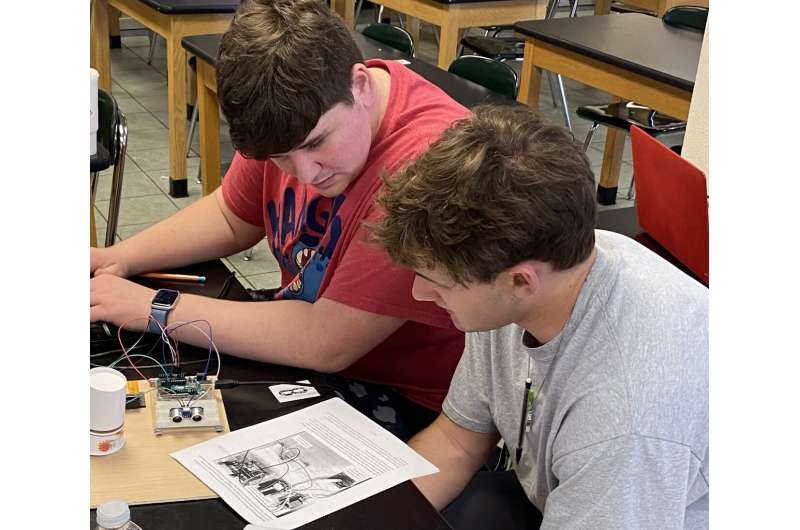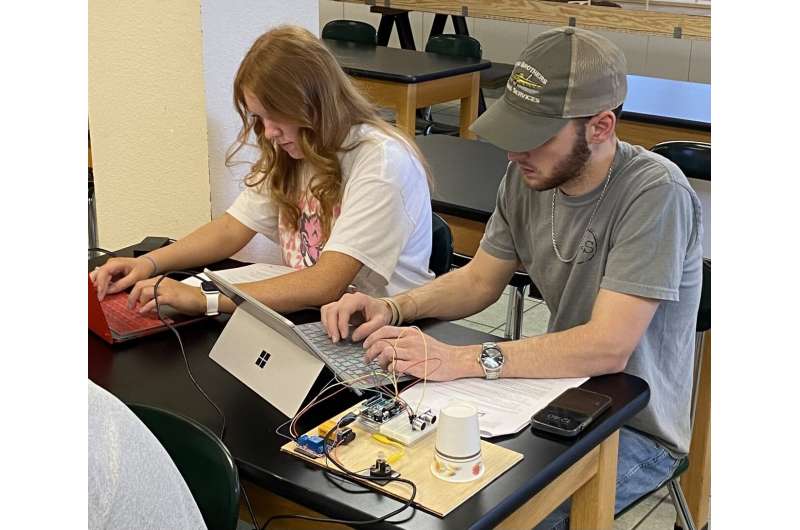
Payton Owens (left) and Wyatt Graves participate in an Agricultural Education, Communication and Technology study for agricultural students to program an Arduino microcontroller using ChatGPT. Photo credit: U of A System Division of Agriculture
Artificial intelligence tools like ChatGPT are showing promise as a useful tool for writing simple computer programs for microcontrollers in agriculture, according to a study published this month.
Microcontrollers are small computers that can perform tasks based on user-written computer programs. They receive input from sensors and can be used in climate and irrigation controls, food processing systems, and robotic and drone applications, to name a few agricultural applications.
A recent study published in collaboration with the Arkansas Agricultural Experiment Station and the Dale Bumpers College of Agricultural, Food and Life Sciences showed that agricultural students who were not familiar with computer programming could use ChatGPT to program a microcontroller to perform a simple task.
“Generative AI can have a huge impact on agriculture… I can’t imagine it wouldn’t,” said Don Johnson, university professor of agricultural education, communication and technology and lead researcher on the project. “We need to prepare our graduates to be part of that.”
“Generative” refers to the tool’s ability to create content.
Johnson’s latest study on this topic, titled “Use of Generative Artificial Intelligence by Agricultural Students for Microcontroller Programming,” was published in Scientific education Journal in August. Co-authors included Bumpers College faculty members in the Department of Agricultural Education, Communication and Technology Will Doss, assistant professor, and Christopher Estepp, associate professor.
Johnson said that computer programming is not typically taught in most agricultural degree programs, but the inclusion of microcontrollers as components of agricultural equipment and systems has become more common. While there will always be a demand for individuals with in-depth knowledge of computer programming, Johnson explained that the focus of these studies was to explore how people without in-depth knowledge can use microcontrollers in their academic and professional careers.
Johnson conducts research on human capital development and agricultural technologies for the Experimental Station, the research arm of the University of Arkansas’s Department of Agriculture.
“I think we’ve found that using generative artificial intelligence, agricultural students can write code to solve moderately difficult programming problems without having any deep programming knowledge,” Johnson said.

Olivia Hope (left) and Jack Freeman participate in an agricultural education, communications and technology course for agriculture students to program an Arduino microcontroller using ChatGPT. Photo credit: U of A System Division of Agriculture
Origins of the study
Johnson began looking into AI-assisted programming in 2022 when ChatGPT was released and learned that it could write code for microcontrollers like Arduinos. Shortly after, he conducted a preliminary study comparing the skills, interest, and confidence of two groups of agriculture students who programmed a microcontroller to blink two LEDs in a specific order. One group of students wrote their own programs, while the other group used ChatGPT.
The results showed that students who wrote their own programs developed more confidence and skills in Arduino programming than beginners who used ChatGPT. However, both groups were equally successful and equally interested in learning more about the microcontrollers and programming.
The follow-up study, published in August, was conducted exclusively with agricultural students with no significant programming experience. The goal of the study was to determine their ability to use ChatGPT to write Arduino code for a more challenging problem than the first study. In this second study, students had to use ChatGPT to program the Arduino to turn on a transfer pump when the solution level in a heating tank fell 20 cm or more below a sensor, and then turn the pump off when the tank was filled to within 7.5 cm of the sensor.
“To write code for this problem in the second study would require a certain level of programming knowledge, and none of these students were able to do that,” Johnson said. “But they were successful. Nine of the 11 teams of two were able to get the code to do exactly what it was supposed to do.”
ChatGPT coaching in both studies included educating students on what makes a good prompt for the generative AI platform. A good prompt, Johnson explained, would clearly describe the situation, components and connections, and the desired outcome.
Go one step further
Johnson wants to take the experiment one step further by leaving the problem open. Students should come up with their own scenarios and write the code for a microcontroller using ChatGPT.
“I want to give students the confidence to approach microcontrollers in a problem-solving manner and say, ‘Yes, I can use this tool to solve my problem,'” Johnson said.
Further information:
Johnson, DM et al. Use of generative artificial intelligence by agricultural students for microcontroller programming, Scientific education (2024). DOI: 10.1002/nse2.20155
Courtesy of the University of Arkansas Department of Agriculture
Quote: Study shows successful use of ChatGPT in agricultural education (21 August 2024), accessed on 21 August 2024 from https://phys.org/news/2024-08-successful-chatgpt-agriculture.html
This document is subject to copyright. Except for the purposes of private study or research, no part of it may be reproduced without written permission. The contents are for information purposes only.

